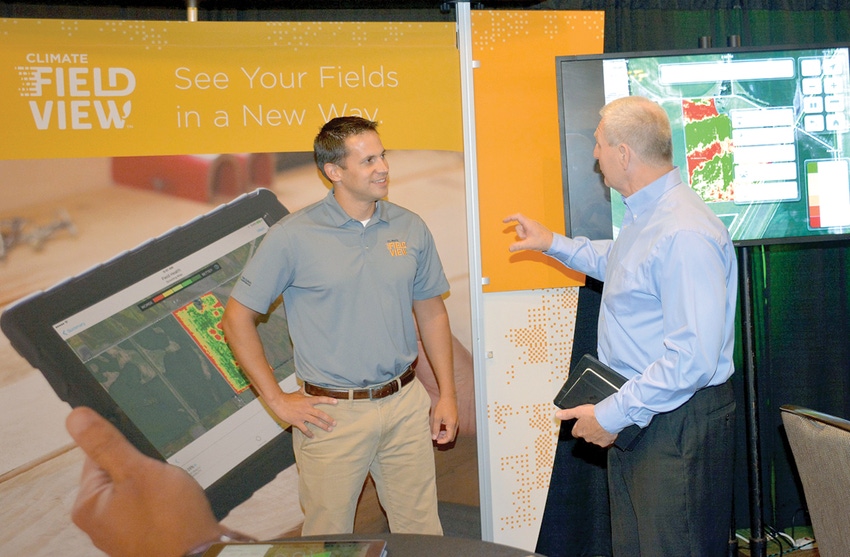
Agriculture is on the cusp of another revolution as farmers and their key suppliers of goods and services tap the potential of rapidly changing technology.
At the recent Winfield US Answer Tech Summit in Dallas, leaders from across a wide spectrum of industries that interact with agriculture offered short-and long-term analyses of how technology — which they agree is changing exponentially — will affect the company’s many retailers, as well as their farmer customers.
They discussed how technology — including improved communications; better, more accurate sensors; and programs that provide actionable information to help farmers and their advisors — will improve cropping and marketing decisions.
Here are 10 key takeaway points from their presentations:
1. “All agronomy is local,” says Mike Vande Logt, executive vice president and chief operating officer for WinField US. “Local agronomists know what goes on in a particular area; they also benefit from local accountability.”
Local advisors, working closely with farmers, he says, are better able to use specific technology — including field sensors, GPS, yield monitors and other tools — to help growers make decisions on hybrid selection, in-season nutrient management, and whether a certain hybrid will benefit from fungicide application.
“We have a tremendous opportunity today to attain high yield potential and we can use new technology to inform a farmer when he needs to apply inputs.”
Using data has become easier, Vande Logt says, and storing it has become a bargain. “In 1980, storing 1 gigabyte of data cost about $192,000; today, storing that data costs 4 cents.”

Mavrx regional sales manager Jeff Divan with Anna Schneider explains the role imagery and analytics play in improving crop health.
Mavrx regional sales manager Jeff Divan with Anna Schneider explains the role imagery and analytics play in improving crop health.The next phase, he and other speakers contend, will be to make better use of collected and stored data. “We have to know when to put our feet on the brakes as well as when to put our feet on the gas.”
Technology, the leaders say, will provide the answers.
2. “Technology is changing exponentially,” says Marcus Shingles, chief executive officer of XPRIZE Foundation, and those rapid changes will mean even greater access to information.
“A cell phone today is 30 times more powerful than anything NASA had just 35 years ago,” he says. Growth may mean doing things 10 times better, or growing 10 times faster rather than trying to achieve a 10 percent annual growth rate. Robotics offers significant opportunity to change, he says. “Robots can now teach themselves — science fiction is becoming reality.”
Computing power may increase in one year as much as it did the previous 30 to 40 years, Shingles says. “Social media and biotechnology will change exponentially.”
3. “All technology is personal,” says Teddy Bekele, WinField US vice president of corporate information technology.
Ag retailers can collect data from digital communications that will help them make recommendations to farmers. “We can help a producer grow more for less,” Bekele says. “We can provide information that will help to manage risk, in addition to improving yield potential. We are in an ag technology revolution.”
4. “Adapt: differentiate or die,” warns John Venhuizen, chief executive officer and president of Ace Hardware.
Retailers have to look at local opportunities, he says. “Think like a small business owner: If you want to get big, think small; if you want to go global, think local.”
Small businesses have three Cs in common, he says: Capital intensive, Complexity, and Competitiveness — all of which are increasing.
A local business is part of and should support the community, Venhuizen says. “A servant heart is not the enemy of a profitable business: Give back and stand for something way bigger than yourself. What we do, and how we do it, matters.”

Timothy Foss with More Belief captured the essence of each Answer Tech Summit presentation on whiteboard. His renderings offered participants an opportunity to review key points of each presentation when they were on display outside the meeting room.
Timothy Foss with More Belief captured the essence of each Answer Tech Summit presentation on whiteboard. His renderings offered participants an opportunity to review key points of each presentation when they were on display outside the meeting room.is occurring in agriculture, says Brett Bruggeman, senior vice president of strategic development for Winfield US. But he questions: “Is ag retail ready for digital engagement? The ag industry is the least digitized industry.”
Yet, farmers are increasingly adopting technology, adding sensors, data storage, and other tools to analyze and make data useful in management decisions.
“Seventy percent of farmers use the internet daily; 80 percent use GPS technology,” and he says, 70 percent of U.S. farmers account for 70 percent of the agricultural acreage.
Technology also offers challenges, Bruggeman says, especially given social media’s ability to hijack issues. “Social media is outweighing science on GMO and some pesticide issues.”
6. “The second wave of digital technology,” is beginning to form, says Janet Schijns, vice president for Global Channels for Verizon. “This second wave is creating brand new sources of revenue, and providing different ways to bring services and products to customers.”
The second wave is also hitting agriculture, Schijns says. “Sensors in grain storage bins can now detect moldy grain and can alert buyers to send trucks elsewhere. These sensors also help farmers eliminate mold problems.” And, she says, analysis of sensor data can pinpoint what causes the mold to form and allow farmers to make adjustments.
7. “Data is local,” says Joel Wipperfurth, ag technology applications lead for WinField US. Technology is “an accelerant” to collect and manage data for developing production management programs.
The WinField US R7 tool assists advisers in offering better management recommendations to farmers, he says. Corn yield potential is far above the actual national average, he says. The recent record U.S. yield of 530 bushels per acre offers a target significantly higher than the average of 170 bushels. “That 360 bushel yield gap is an opportunity for technology.
Hybrid characteristics trials in Winfield US “Answer Plots” demonstrate how a specific hybrid performs under various production regimes, including rotation practices, soil types, nitrogen rates, weather conditions, and disease pressure. “We can win the right to recommend,” Wipperfurth says. In-season management works best with local data, not with “silicon data,” he says.

Microsoft chief marketing officer Grad Conn stopped by the model satellite display during the Winfield Ag Answer Tech Summit Showcase. Conn says, “Wherever you are, you’re always connected,†through communications technology.
Microsoft chief marketing officer Grad Conn stopped by the model satellite display during the Winfield Ag Answer Tech Summit Showcase. Conn says, “Wherever you are, you’re always connected,†through communications technology.says Grad Conn, chief marketing officer for Microsoft. “Wherever you are, you’re always connected,” with tablets, smart phones, or computers.
Farmers in the field have instant access to weather and market data; they also have planting records and management applications at their fingertips.
“We are now in the fourth industrial revolution,” Conn says. “We have autonomous vehicles, robotics, biologicals, and digital communications.”
9. “Leverage the power of data to optimize yields,” says Mike Stern, chief executive officer of The Climate Corporation, Monsanto.
“We use digital tools to create value for farmers.” The process should include using weather data to affect production models. “Farmers and advisers have layers of data collected through yield monitors and sensors. Growers are still looking at how to take advantage of the data.”
Data science — analytics — provides tools for farmers and trusted advisers to use in decision-making, Stern says, including in-field and in-season applications. “Our new tools will function on an iPad. Farmers want mobile access.”
More information, and easier access to that information, will be imperative in coming years, he says. “For instance, we need tools that allow us to be more accurate and efficient with nutrient applications. More regulation is coming and we need to get ahead of the curve. We have a long way to go with digital agriculture — but it will change the way we farm.”
10. “Doesn’t the future eventually have to become the present?” asks Aaron Ault, project lead for the Open Ag Technology Group at Purdue University.
“Open source ag data needs to happen. We have a lot of tools available, but they don’t talk to each other. We see no need to reinvent the wheel every time we log onto a different digital tool.”
Developing methods to cross-communicate between data systems was the reason for developing an Open Ag Data Alliance (OADA), Ault says. “A farmer’s core business is logistics — he needs answers now.”
Precision agriculture has been around for 25 years, “but we still don’t use the data for logistics, we don’t use the data for evaluation. The values for many products and services have not been established. For instance, we are paying for yield monitors we don’t use.”
It’s an ideal opportunity for service providers, Ault says. “Farmers want to farm, not do the data stuff.”
ACCESS TO DATA
And they want easy access to data they’ve collected and stored on a machine or a thumb drive, he says. The Cloud is “a new storage box” that holds information that’s not otherwise easily accessible. It’s a digital version of the shoebox many farmers have used to store notebooks filled with crop information — and rarely used to make management decisions.
Retailers can provide that service but they have challenges to overcome. Trust is a big one. “No trust equals no customers,” Ault says. “The Cloud can be about selling trust and keeping data secure.”
He says farmers will need assurances from retailers who will supply access and recommendations from their data. “First, no surprises,” he says. “Do what you say you will do with the data. Next, have a written agreement and make certain the farmer knows what’s in it. Make the items in the agreement modular so he can buy only the ones he wants without having to buy a package of stuff he doesn’t need.
“Make sure the service solves a real problem. Have a legitimate reason for collecting the farmer’s data. Create problem-solving apps to make data useful.”
INTEGRATION OF DATA
In his keynote address, Chris Policinski, president and chief executive officer of Land O’ Lakes, the parent company of WinField US, put the challenge and opportunity for ag technology in perspective.
In less than 50 years, he notes, the world will have to produce twice as much food and fiber on about half as much land, with less water than is available now. “We can do it. In the U.S., the increase will be yield-driven; we don’t have that much land we can till.”
The yield increases will come from efficient seed, nutrient, and crop protection applications, which will depend on technology, Policinski says.
“We know about working with farmers. Land O’Lakes started out working with small farmers.”
The next opportunity, he says, will be capitalizing on WinField US technology to advise farmers. “Phase 1 of precision agriculture is already in place; Phase 2 will be integrating data to increase yield, drive down costs, and improve sustainability.”
About the Author(s)
You May Also Like






